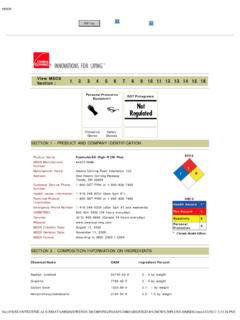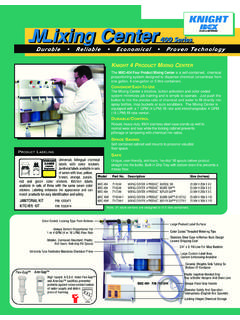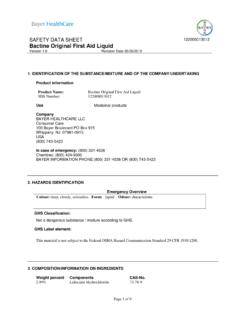Transcription of MATERIAL SAFETY DATA SHEET - RPM Services, LLC
1 MATERIAL SAFETY data SHEET SECTION I - PRODUCT IDENTIFICATION universal Lubricants, Inc. PRODUCT CODE: G990 2824 N. Ohio, Wichita, KS 67219 REV. DATE: 10/11/02 EMERGENCY PHONE: (316) 832-0151 TRADE NAME: DYNA-PLEX 21C ULTRA BLUE #2 SYNONYMS: Petroleum Lubricant CAS REG. NO.: Mixture NFPA Hazard Classification: HEALTH - 0; FLAMMABILITY - 1; REACTIVITY - 0; (Least=0; Slight=1; Moderate=2; High=3; Extreme=4) SECTION II - INGREDIENTS Component Name Hazardous Approx. OSHA/ACGIH CAS Number in Blend % PEL/TLV Base Lubricating Oils Mixture No 80-90 None Lithium Soap Thickener Trade Secret No 1-5 None Additive Package Trade Secret No 10-15 None SECTION III - PHYSICAL data -Specific Gravity (H20=1): -Appearance: Blue, Smooth -Odor.
2 Mineral Oil -Solubility in Water: Negligible @25 C -Vapor Pressure: N/A -Boiling Point: N/A -Percent Volatile: N/A -Molecular Weight: Variable SECTION IV - FIRE PROTECTION INFORMATION -Flash Point ( ): 204 C, (400 F) -Flammable Limits in Air, % by volume: Lower-N/A; Upper-N/A -Extinguishing Media: Use dry chemical, foam or carbon dioxide. -Unusual Fire and Explosion Conditions: Do not weld, heat or drill containers.
3 Dense smoke may be generated while burning. Carbon monoxide, carbon dioxide and other oxides may be generated as products of combustion. -Special Fire Fighting Procedures: Do not enter confined fire space without proper protective equipment. Cool fire exposed containers with water. Caution should be exercised when using water or foam as frothing may occur, especially if sprayed into containers of hot, burning liquid. SECTION V - REACTIVITY data -Stability: Stable. -Conditions to Avoid: Heat, open flames, oxidizing materials and mist.
4 -Incompatibility: May react strong with oxidizing agents. -Hazardous Polymerization: Will not occur. -Hazardous Decomposition Products: Carbon monoxide and carbon dioxide from burning. Page 2 of 2 SECTION VI - PERSONAL HEALTH PROTECTION INFORMATION Threshold Limit Value: mg/m3 suggested for 8 hour exposure. Eye Protection: If MATERIAL is handled such that it could be splashed into eyes, wear plastic face shield or splash-proof SAFETY goggles. Skin Protection: For prolonged or repeated exposures, use impervious clothing (boots, gloves, aprons, etc.)
5 Over parts of the body subject to exposure. If handling hot MATERIAL , use insulated protective clothing. Launder soiled clothes. Properly dispose of contaminated leather articles, including shoes, which cannot be decontaminated. Respiratory Protection: If vapor or mist is generated when the MATERIAL is heated or handled, use an organic vapor respirator with a dust and mist filter. All respirators must be NIOSH certified. Do not use compressed oxygen in hydrocarbon atmospheres.
6 Adequate ventilation in accordance with good engineering practices must be provided to maintain concentrations below the specified exposure or flammable limits. Ingestion: Food and beverage consumption should be avoided in work areas where hydrocarbons are present. SECTION VII - EMERGENCY AND FIRST AID PROCEDURES Eye Contact: Immediately flush eyes with large amounts of water and continue flushing until irritation subsides. Seek medical attention. Skin Contact: Remove contaminated clothing.
7 Wash contaminated area with soap and water. Do not reuse clothing until thoroughly cleaned. Seek medical attention for persistent irritation. Inhalation: If breathing difficulty exists, remove victim to fresh air. Seek medical attention. Ingestion: Do not induce vomiting. Seek medical attention. Skin Injection: If product is injected into or under skin, or into any part of the body, regardless of the appearance of the wound or its size, the individual should be evaluated immediately by a physician as a surgical emergency.
8 Even though initial symptoms from high pressure injection may be minimal or absent, early surgical treatment within the first few hours may significantly reduce the ultimate extent of injury. SECTION VIII - ENVIRONMENTAL PRECAUTIONS -Steps to be taken if MATERIAL is released or spilled: Consult Personal Health Protection Information (SECTION VI), Fire Protection Information (SECTION IV), and Reactivity data (SECTION V). Notify appropriate authorities of spill. Contain spill immediately. Do not allow spill to enter sewers or watercourses.
9 Remove all sources of ignition. Absorb with appropriate inert materials, such as sand, clay, etc. Large spills may be picked up using vacuum pumps, shovels, buckets, or other means and placed in drums or suitable containers. -Disposal of waste: All disposals must comply with Federal, state and local regulations. Spilled or discarded MATERIAL may be a regulated waste. Refer to state and local regulations. If regulated solvents are used to clean up spilled MATERIAL , the resulting waste mixture may be regulated.
10 Department of Transportation regulations may apply for transporting of this MATERIAL . SECTION IX - HANDLING AND STORAGE -Store only in properly marked containers. Store in closed containers away from heat, sparks, flame or oxidizing materials. -This product is not classified as hazardous under DOT regulations. See NFPA 30 and OSHA --- flammable and combustible liquids.









